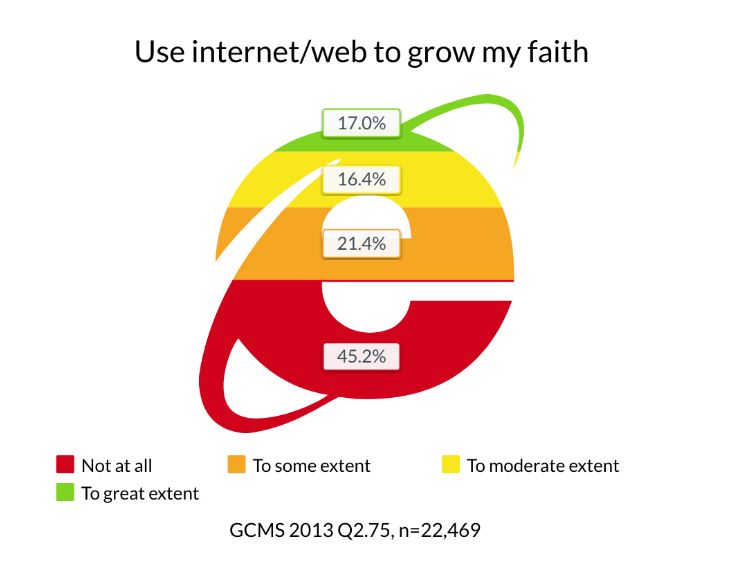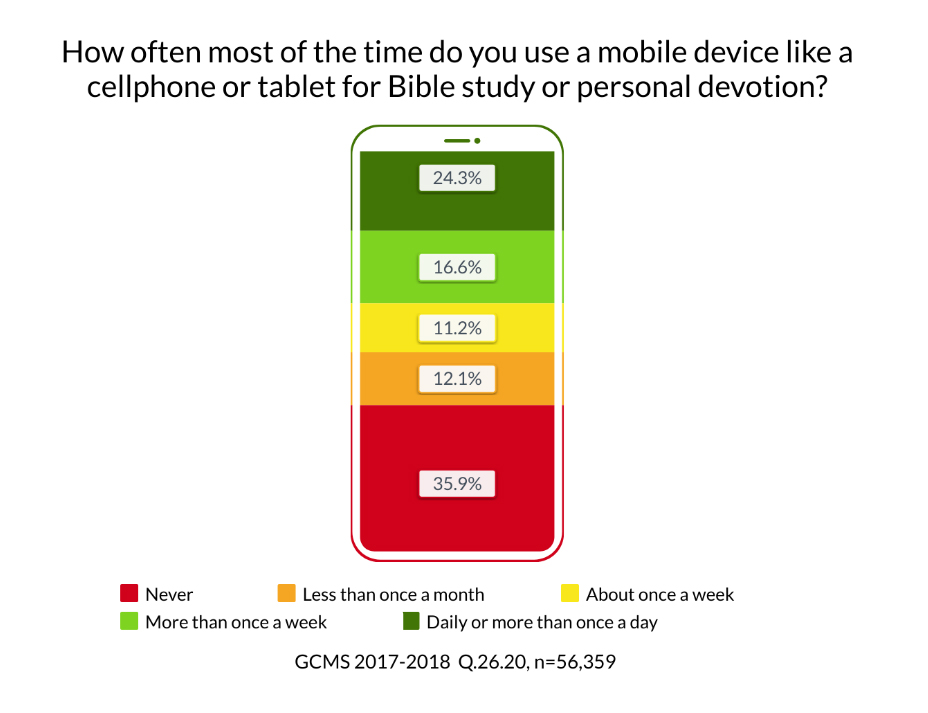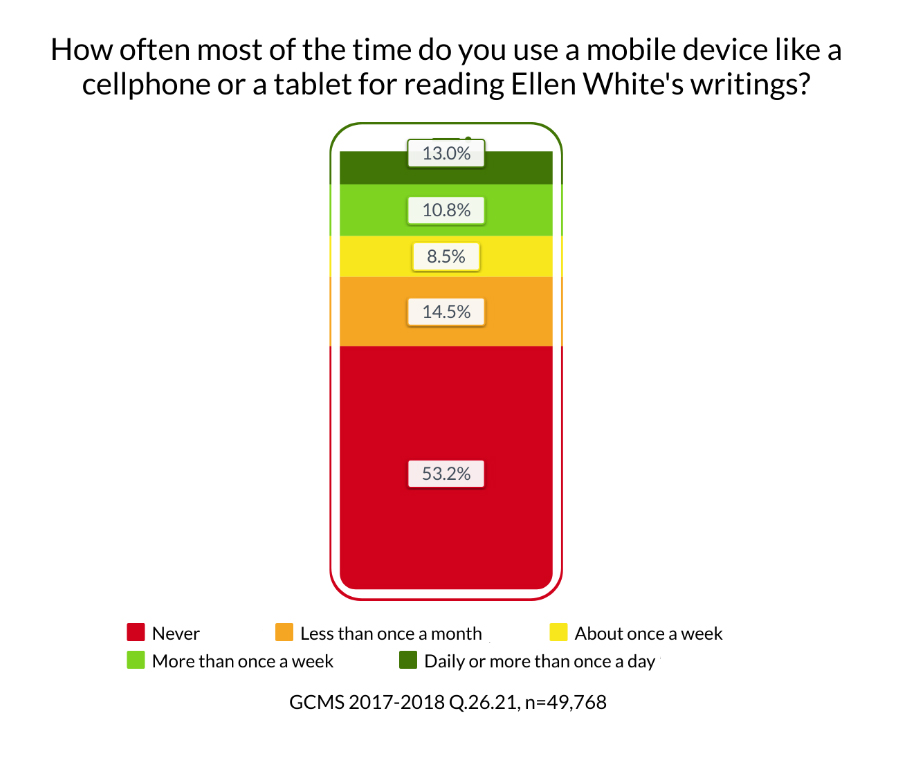How do Adventists use the Internet?

At this time of global pandemic, the Internet has become a lifeline. It’s the chief source of facts about COVID-19; a means of attending church services where they’re currently suspended; and most of all, a way to see our families—indeed, in many cases, simply to see other human beings. What do we know about how Seventh-day Adventist church members use and interact with the Internet? Our recent blog about social media examined the habits of Adventist church members worldwide regarding social media use and questioned if we’re using this resource to its full potential to glorify God. Researchers, however, also wanted to find out how Adventists are using the Internet as a whole to aid in spiritual growth.
The data shared below are taken from 2013 and 2018—well before the COVID-19 pandemic. Nevertheless, the information is both interesting and very important for church leaders as they consider the current (and no doubt future) greatly increased usage of virtual platforms.

As part of the 2013 Global Church Member Survey (GCMS), church members were asked if they use the Internet to grow their faith. Nearly half (45 percent), however, reported that they never did so, while one in three participants reported using the Internet to a moderate or great extent to grow their faith. These were sobering data given the investment the Adventist Church worldwide has put into various virtual platforms.
Between the years of 2013 and 2018, the Internet continued to grow in capacity and usability; additionally, smartphones and tablets became ever more common, providing access to the Internet virtually anywhere and everywhere. Therefore, when the 2017-2018 GCMS was conducted, researchers wanted to determine if—and how—members used their mobile devices in spiritually enhancing activities.
A Surprisingly Untapped Resource
In spite of the enormous potential of mobile devices, the 2018 survey showed they were still largely an untapped resource for Seventh-day Adventists. More than one third of respondents reported never using their cell phone or tablet for Bible study1 or personal devotions.2 Only every ninth respondent (11 percent) utilized a mobile device for this purpose even once a week, and just over 40 percent used a mobile device as part of their Bible study or personal devotions several times per week. Yet this only just exceeded the proportion of respondents for whom mobile devices apparently have nothing to do with their personal devotional life.

Even fewer respondents reported using a mobile device to access and read Ellen White’s writings; more than half of respondents reported never using a mobile device for such a purpose.3 Only 11 percent did so more than once a week, and only 13 percent did so daily.
Ellen White’s writings are currently available online in English, German, French, Spanish, Italian, Portuguese, Russian, Mandarin, Romain, Arabian, and Korean; as such, it should be noted that some of the survey respondents may not have access to Ellen White writings in their native language (see our blog on access to Ellen White’s works in local languages4). This may be one explanation for such a high percentage of those who never use a mobile device to read her writings. Another explanation, however, is a lack of awareness among church members that her writings are available online.

Using Technology in the “Right” Way
The Internet has the potential to be a great resource—one that can be used to grow our relationships with our heavenly Father, as well as to engage with our Christian community in a unique way. The Internet, however, can also be used for much that’s sinful. Ellen White reminds us: “Where there is an abundance of idleness, Satan works with his temptations to spoil life and character.”5 We must be cautious that we’re using this wonderful resource for our edification and growth, not allowing ourselves to be “led into temptation.”
It should also be noted that technology–including social media, apps, and the Internet, at large, can never replace the importance of human interaction and our need for the Christian community. While these communication tools can be used to connect with people, to stay in touch with family and friends, or even to share the gospel, they don’t replace our need for face-to-face interactions. “To make disciples, there is a need for the Church to have a physical presence. At its core, the Church is an assembly of people who gather together with each other in person.”6 That said, many of us are now rethinking how face-to-face interactions can take place. Do Adventist websites perhaps need to develop in the direction of providing a platform for personal interface as well as for providing information?
The results of the Global Church Member Surveys provide much to ponder for both church members and church leaders. When you consider your own Internet and smartphone usage, how often do you utilize them to help you grow spiritually? Now consider: How could you change your habits to use this technology to better enhance your spiritual life? Would you consider using your electronic devices more often for your personal devotions? Would you be willing to share online resources for spiritual growth with your friends? And also important, how can you make changes in your life to ensure that your interactions with others online and in person are in balance? What do Adventist apps and websites need to do to make their resources more appealing, more useful, more spiritually powerful? What can we do, as individuals and as a church, to use the power of the Internet more effectively for mission and ministry? And in particular, how can the mobile devices that are becoming more important than computers be used more effectively to fulfill the Great Commission—to preach and teach?
Adventist Statistics and Research (ASTR) Research and Evaluation Team, headquartered at the General Conference of Seventh-day Adventists in Silver Spring, Maryland, United States, created this article in collaboration with the Institute of Church Ministry (https://icm.adventist.org).
1 The Bible can be accessed on mobile devices by the following methods: (1) Internet—https://www.bible.com; (2) iPhone—https://apps.apple.com/us/app/bible/id282935706; and (3) Android—https://play.google.com/store/search?q=the%20holy%20bible%20app&c=apps&hl=en_US.
2 People use various approaches for personal devotions. If you use the Adult Sabbath School Bible Study Guide, you can access it on mobile devices by the following methods: (1) Internet—https://www.sabbathschoolpersonalministries.org/international; (2) iPhone app—https://apps.apple.com/us/app/sabbath-school-quarterly-app/id874958957; (3) Android app—https://play.google.com/store/apps/details?id=com.ergonlabs.SabbathSchool&hl=en_US. If you use the Revival and Reformation daily devotions, you can access them on mobile devices by the following methods: (1) Internet—https://www.revivalandreformation.org/devotional and (2) Android—https://play.google.com/store/apps/details?id=net.flaviosilva.rpsp.Full&hl=en_US.
3 Ellen G. White’s writings can be accessed on mobile devices by the following methods: (1) Internet—https://egwwritings.org/; iPhone app—https://apps.apple.com/us/app/egw-writings/id374790551; and (3) Android app—https://play.google. com/store/apps/details?id=egw.estate&hl=en_US.
4 https://www.adventistresearch.org/blog/2018/11/writings-ellen-g-white.
5 Ellen G. White, Child Guidance (Nashville, Tenn.: Southern Pub. Assn., 1954), p. 123.
6 J. Wisnewski (2018), “Technology in the Bible: A short guide to Bible verses about technology. Retrieved from https://get.tithe.ly/blog/technology-in-the-bible.








